Tropical Favorites
Coconut Palm (Cocos nucifera)
The Coconut Palm ( Cocos nucifera) reigns supreme as a tropical favorite, embodying the essence of paradise with its swaying fronds and iconic fruit.
Native to the Indo-Pacific region, this majestic tree thrives in coastal areas, thriving in sandy soils close to the sea. Its tall, slender trunk can reach heights of over 30 meters, crowned by a dense crown of feathery fronds that offer a welcome respite from the tropical sun.
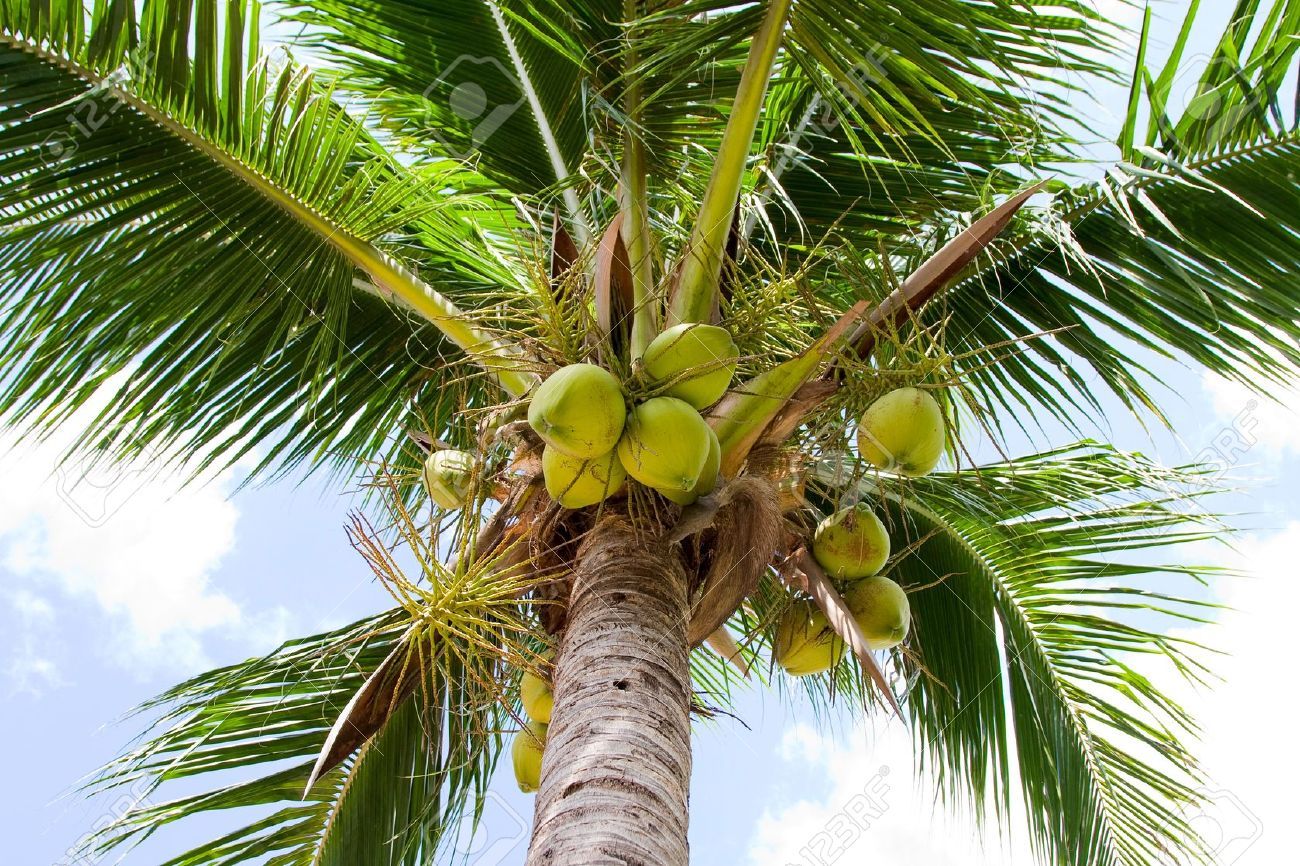
The coconut palm is renowned for its versatile coconuts, a nutritional powerhouse offering both food and drink. The young green coconut’s refreshing water quenches thirst, while the mature brown coconut yields sweet, edible flesh. Beyond culinary uses, coconuts are also processed to produce coconut milk, oil, and various other products.
Beyond its economic significance, the coconut palm holds deep cultural importance in many tropical societies. It features prominently in folklore, mythology, and traditional ceremonies. Its leaves are woven into mats, baskets, and even roofing materials, while its trunk provides sturdy timber for construction.
Whether gracing idyllic beaches or adorning lush gardens, the Coconut Palm stands as a symbol of tropical abundance and enduring beauty.
Date Palm (Phoenix dactylifera)
Date Palm (Phoenix dactylifera) is a quintessential desert tree, bearing succulent fruits that have been a staple food source for centuries.
Native to the Middle East and North Africa, Date Palms thrive in hot, arid climates with full sun exposure. They are remarkably resilient, tolerating drought conditions and even occasional frosts.
These majestic trees can reach impressive heights, sometimes exceeding 70 feet tall, with a crown of feathery fronds that provide welcome shade in scorching environments.
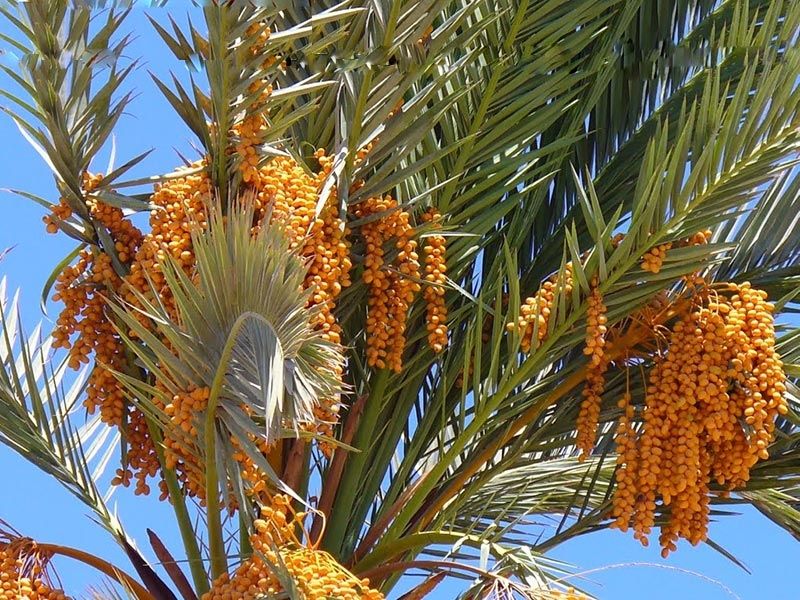
The edible fruit of the Date Palm is technically a berry and comes in a wide array of varieties, each with its unique flavor profile ranging from sweet to tangy.
Date Palms are not only valued for their delicious fruit but also for their practical applications. Their strong wood has been used for construction, furniture, and even woven into baskets and mats.
You can find Date Palms growing in tropical and subtropical regions around the world, including the Middle East, North Africa, Spain, California, and Australia.
They are a popular ornamental tree, adding a touch of exotic elegance to gardens and landscapes.
Royal Palm (Roystonea regia)
- Standing tall and elegant, the Royal Palm (Roystonea regia) reigns supreme as a quintessential tropical favorite.
- Native to Cuba and the Caribbean, this magnificent palm tree graces landscapes throughout Florida, Hawaii, and other subtropical regions.
Its striking beauty stems from its distinctive features:
- Crown Shape: A majestic, spreading crown of feather-like fronds, adding a touch of grandeur to any surroundings.
Trunk:
- A smooth, gray trunk that tapers towards the top, often adorned with prominent leaf scars, whispering tales of its growth and history.
Growth Habit
- It typically reaches a height of 60 to 80 feet, making it a towering presence in tropical landscapes.
- The Royal Palm thrives in sunny locations with well-drained soil. Its adaptability allows it to withstand various conditions, including salt spray near coastal areas.
- Beyond its visual appeal, the Royal Palm holds cultural significance in many regions. It is often associated with prosperity, elegance, and tropical paradise.
Subtropical Standouts
California Fan Palm (Washingtonia filifera)
Standing tall and proud against the arid backdrop of deserts and dry valleys, the California Fan Palm (Washingtonia filifera) reigns supreme as a symbol of enduring strength and resilience in the face of harsh conditions. This magnificent palm tree, with its iconic fan-shaped leaves and towering trunk adorned with distinctive rings, has earned its place as a standout among subtropical species.
Native to the southwestern United States and Mexico, the California Fan Palm thrives in climates characterized by warm temperatures and low rainfall. Its deep root system enables it to access water deep underground, allowing it to withstand prolonged periods of drought. The tree’s signature fan-shaped leaves are remarkably adapted for arid environments; they have a thick, leathery texture that minimizes water loss through transpiration. These large leaves unfurl from the top of the trunk, creating a magnificent umbrella-like canopy that provides shade and cools the surrounding air.
The California Fan Palm’s impressive stature can reach heights of over 60 feet, making it one of the tallest palm species in North America. Its trunk is covered with prominent brown rings that serve as visual reminders of its age. These distinctive rings are formed by the shedding of leaf scars, each scar representing a year of growth.

Beyond its remarkable adaptability and aesthetic appeal, the California Fan Palm holds significant cultural value. Native American tribes have long revered this tree for its medicinal properties and practical uses. Its leaves were used for weaving baskets, mats, and other utilitarian items, while its wood was employed in construction and crafting. The tree’s abundant shade provided refuge from the scorching desert sun, making it a valuable resource for travelers and wildlife alike.
Today, the California Fan Palm is a beloved symbol of the American Southwest and continues to be widely planted in gardens, parks, and landscapes throughout its native range and beyond. Its majestic presence adds a touch of exotic beauty and grandeur to any setting, while its resilience serves as an inspiration for enduring strength in the face of challenges.
Windmill Palm (Trachycarpus fortunei)
Subtropical standouts, Windmill Palms (Trachycarpus fortunei), are a resilient and striking addition to any landscape seeking a touch of tropical elegance.
Native to the mountains of eastern Asia, these hardy palms have earned their reputation for tolerating cold temperatures with remarkable fortitude. While they thrive in USDA hardiness zones 7-10, they can withstand occasional dips down to -15°F (-26°C) making them a viable option for even more northerly climates.
Their name, Windmill Palm, aptly describes their distinctive silhouette. The crown boasts a majestic array of feather-like leaves that resemble the blades of a windmill, gracefully arching upwards from a single central trunk.
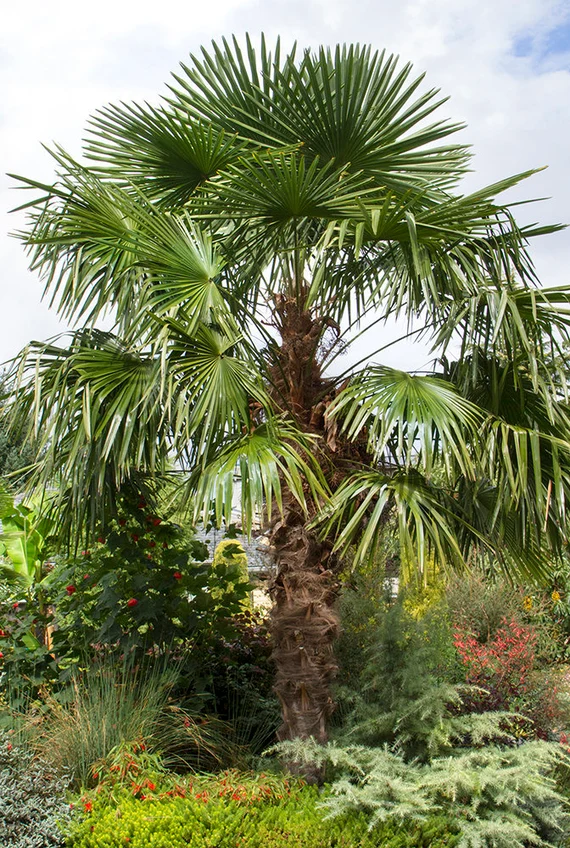
Adding to their allure, these palms exhibit an elegant architectural form. Their stout trunks, often adorned with prominent leaf scars, stand tall and imposing, reaching heights of 20 to 30 feet in ideal growing conditions. The leaves themselves, each measuring up to 4 feet long, cascade downwards, creating a lush, tropical atmosphere.
Windmill Palms are incredibly versatile. They thrive in full sun to partial shade, adapting well to various soil types, making them suitable for a range of landscape designs.
In addition to their aesthetic appeal, Windmill Palms offer valuable benefits. Their dense canopy provides welcome shade during scorching summer days, while their upright growth habit makes them ideal for creating privacy screens or windbreaks.
Mediterranean Fan Palm (Chamaerops humilis)
Mediterranean Fan Palm (Chamaerops humilis) is a true icon of the Mediterranean region, renowned for its striking fan-shaped leaves and resilience in hot, arid climates.
This palm thrives in full sun and well-drained soil, tolerating both heat and occasional drought with ease. Its slow growth rate and compact size make it an ideal choice for smaller gardens or containers.
Here are some key features of the Mediterranean Fan Palm:
- Fan-Shaped Leaves: The most distinctive feature is its palmate leaves, resembling large fans that gracefully arch outwards from a central crown.
- Drought Tolerance: This palm is highly drought tolerant once established, making it perfect for regions with limited rainfall.
- Compact Size: Reaching a mature height of around 10 feet tall, this palm is well-suited for smaller spaces.
- Sun Lover: It thrives in full sun, needing at least six hours of direct sunlight daily.
- Wind Resistance: The Mediterranean Fan Palm can withstand strong winds, making it a hardy choice for coastal areas.
Unique Exotics
Pygmy Date Palm (Phoenix roebelenii)
The Pygmy Date Palm (Phoenix roebelenii) is a popular choice for both indoor and outdoor spaces, thanks to its compact size and graceful appearance.
Native to Southeast Asia, this palm thrives in warm climates and enjoys bright, indirect sunlight. It’s known for its slender, arching fronds that create a delicate, feathery canopy. Its trunk, typically reaching no more than 10 feet tall, is covered in distinctive gray scales, adding to its unique charm.
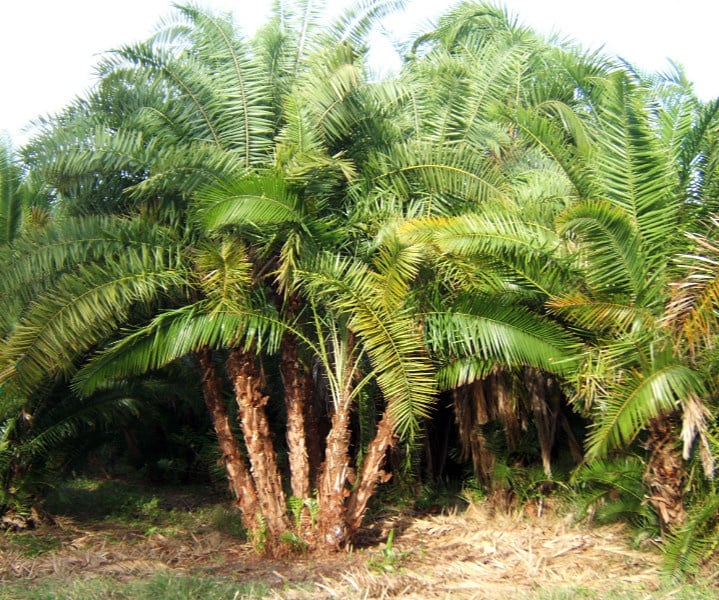
The Pygmy Date Palm is remarkably adaptable and tolerates various soil types, making it a versatile option for gardeners. It can withstand occasional drought but prefers consistently moist soil.
This palm species is also relatively easy to care for. Regular pruning helps maintain its shape and removes any damaged fronds.
While the Pygmy Date Palm does produce small, edible dates, its primary appeal lies in its ornamental value.
Silver Thatch Palm (Coccothrinax argentata)
The Silver Thatch Palm (Coccothrinax argentata) is a truly unique and fascinating palm tree native to Cuba. Its silvery-green leaves, which gracefully arch towards the ground, give it a distinctive and ethereal appearance. This beauty thrives in full sun and well-drained soil, making it a perfect choice for arid regions or coastal areas with sandy soils.
Unlike many other palm species, the Silver Thatch Palm is remarkably drought-tolerant. Its shallow roots spread out wide to absorb moisture from even the smallest amount of rainfall, allowing it to survive in environments where other plants struggle. This resilience makes it a popular choice for landscaping projects in regions with limited water resources.
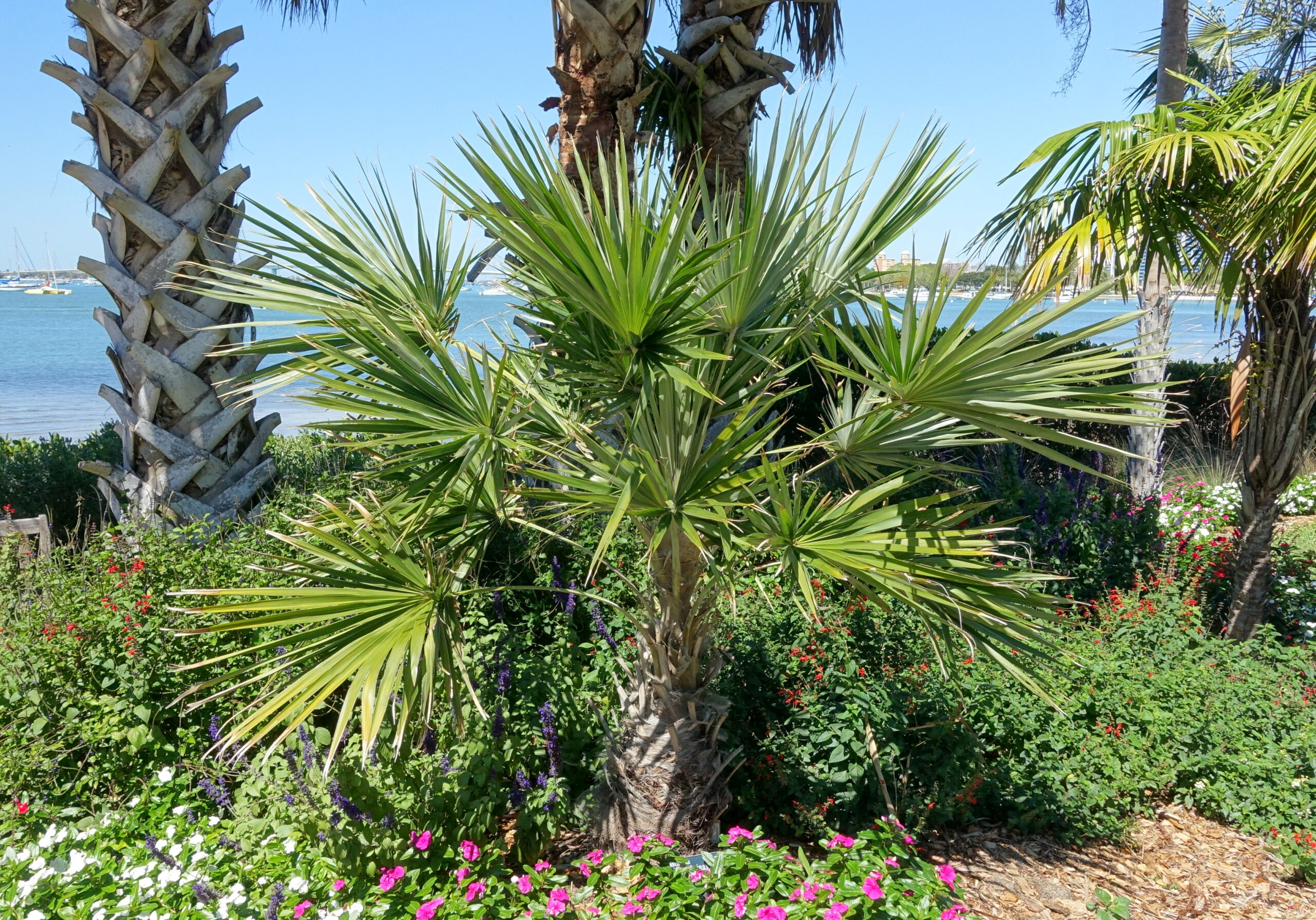
The Silver Thatch Palm is also incredibly adaptable and can withstand various environmental conditions. It tolerates salt spray, making it suitable for coastal plantings, and it can even thrive in slightly acidic soils. This versatility has allowed it to become a sought-after ornamental tree in many parts of the world.
Beyond its striking appearance and resilience, the Silver Thatch Palm holds cultural significance in Cuba. Traditionally, locals have used its leaves for roofing materials, weaving baskets, and creating mats. Its strong, fibrous fibers have proven invaluable for various crafts and household items, highlighting the tree’s practicality as well as its aesthetic appeal.
Fishtail Palm (Caryota urens)
The Fishtail Palm (Caryota urens) is a striking and unique palm tree native to Southeast Asia, particularly Indonesia, Malaysia, and Thailand.
It earns its common name from the distinctive shape of its leaves, which resemble fish tails or giant fronds. These leaves are palmately compound, meaning they divide into numerous leaflets radiating out from a central point, creating an almost feather-like appearance.
Fishtail Palms can grow to impressive heights, reaching up to 30 meters (100 feet) tall in optimal conditions. They are prized for their ornamental value and are frequently cultivated as landscape plants in tropical and subtropical regions.
Here’s a closer look at some of the key characteristics of this exotic palm:
- Leaves: The most striking feature of the Fishtail Palm is its large, uniquely shaped leaves. These palmate leaves divide into numerous leaflets that create a distinct fishtail-like appearance.
- Stem: The trunk of a mature Fishtail Palm is relatively slender and smooth, often covered in remnants of leaf sheaths.
- Flowering and Fruiting: This palm produces large, drooping inflorescences (flower clusters) that are followed by small, fleshy fruits.
- Growth Habits: Fishtail Palms prefer warm, humid climates and well-drained soil.
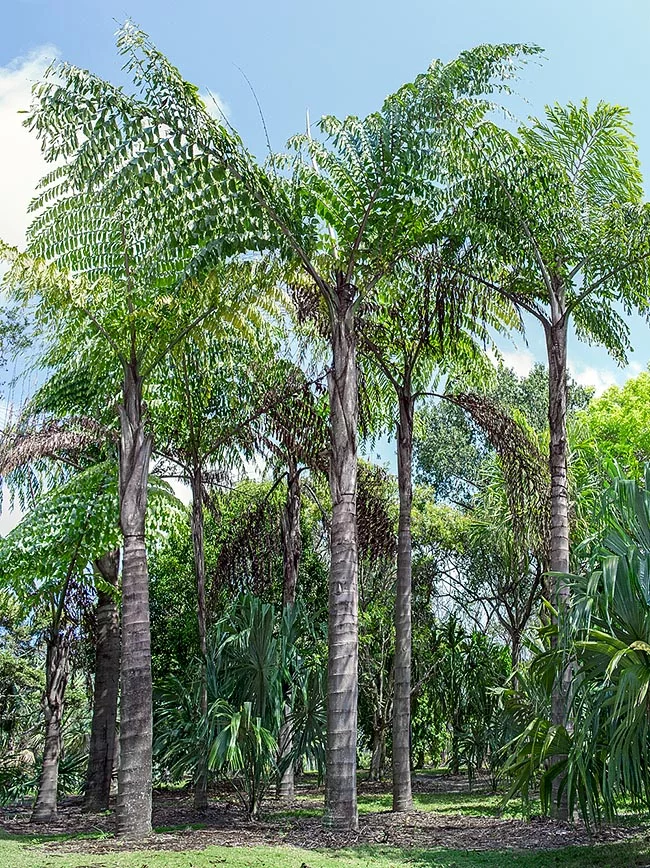
While these palms can thrive in outdoor gardens in tropical regions, they may also be suitable as houseplants for those who live in colder climates. However, providing them with ample light and humidity is essential for their success indoors.
If you are looking for a truly unique and eye-catching addition to your garden or indoor space, the Fishtail Palm (Caryota urens) is a fantastic option.
- 10 Fascinating Facts About Caribbean Culture - September 30, 2024
- 10 Countries Without Universal Healthcare - September 30, 2024
- 10 Examples Of Genetic Hybrids - September 30, 2024


